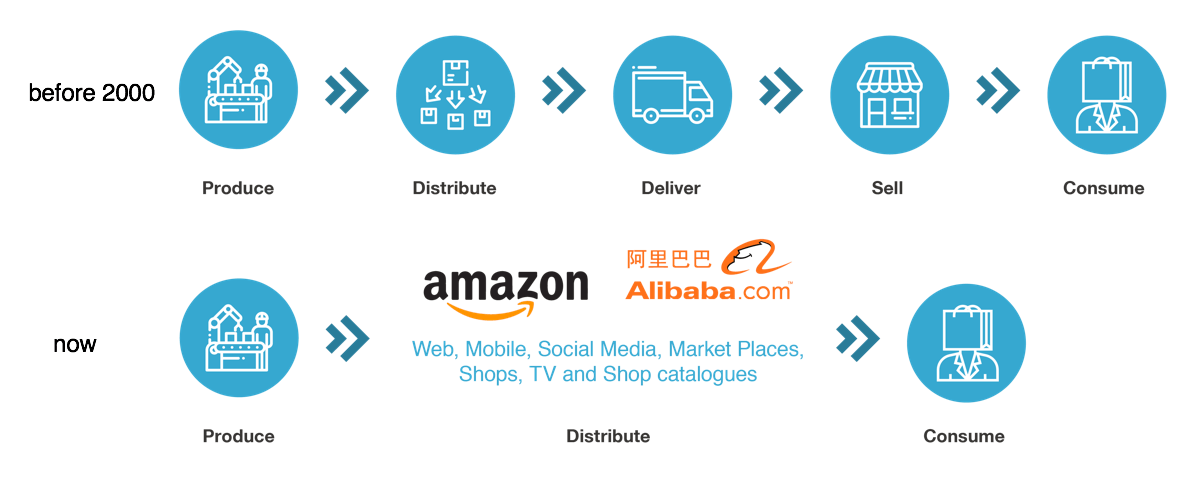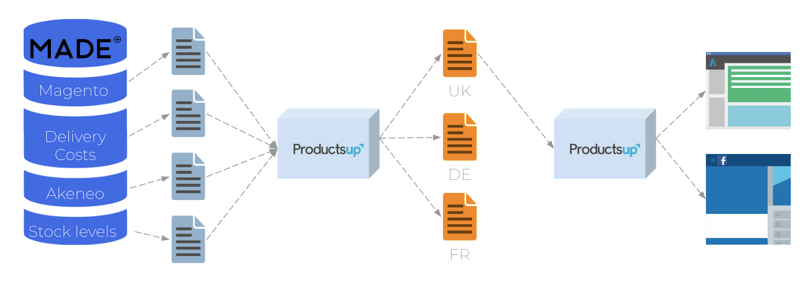The annually held Akeneo PIM Summit gives PIM users and partners the opportunity to share experiences, knowledge, and insights with one another. Each year, C-level decision makers, marketing and ecommerce teams, IT project managers, and Akeneo partners gather to discover the latest PIM and PXM industry trends, to learn about upcoming Akeneo product enhancements, and to build their technical expertise with engaging workshops.

As an Akeneo partner, Productsup had the opportunity to take to the stage with Made.com—a joint client of ours and Akeneo—at this years PIM Summit in Paris, France. During the talk, Emile Bloemen—SVP Enterprise & Commerce at Productsup—and Tim Roberts—Senior Paid Search Manager at MADE.COM—provided an in-depth look into common product content integration and syndication challenges. They went on to offer actionable insights to help companies solve syndication struggles.
Missed the talk? No problem. Here is an in-depth summary of Productsup’s and Made.com's talk at Akeneo Pim Summit 2019.
The rise of customer-focused retail
The traditional retail industry is in the midst of a dramatic change, from mediocre to customer-focused retail. Who’s driving this change? All of your B2B and B2C customers. They know exactly what product information they’d like, where to shop, where to share and read product reviews, and how to talk to their peers around the world via social media. Today, the customer is in control. What’s more? According to Forrester, consumers visit an average of 14 different channels before they make a purchase decision.
For retailers and brand manufacturers, this shift in consumer behavior sparks the need to be present on all of these channels. Those who aren’t, are stuck and aren’t sure how to get there.
“You are not stuck in traffic, you are traffic”
-Emile Bloemen, SVP Enterprise, Commerce at Productsup
So what do you do? Imagine you are stuck in a traffic jam. Some might deal with this by investing in a more comfortable car or a bigger car, after all, if you’re going to be there for a while, you might as well be comfortable, right? Wrong. Companies who use this approach won’t get any closer to being present on more channels.
Others might think to bypass the traffic flying over it with a helicopter, or buying a motorbike to increase the agility of your route. It’s exactly this innovative thinking that will allow retailers and brand manufacturers to thrive in this constantly evolving customer-centric retail space.
What this means for retailers and brand manufacturers
Nowadays, retailers and brands need to be on multiple channels and in multiple countries in order to be present wherever their customers are looking. Productsup, for example, has clients who leverage 650 unique channels across 65 countries.
Moreover, the entire structure of retail has changed. Before 2000, it was quite straightforward. Manufacturers would produce products, wholesalers would purchase in bulk and sell to retailers, products would be sold to shops and then to consumers. Now, however, manufacturers and wholesalers themselves can sell directly to customers. The result? All types of channels and the need for companies to have the agility required to get their products on them.

So how can you get there? Start by asking yourself a few questions
- __Where do your customers shop and get information?__ It’s likely not just your own website. Could it be Google, Amazon, or Pinterest?
- __Where is your product data inside and outside of your company?__ First, locate it, then figure out how to get it in front of your customer. Check all types of silos, images, tracking data, financial data, etc. How can you bring it all into one place?
- __Are there any walls preventing you from accessing or publishing your data?__ Could these individual silos be limiting the agility of your data? Removing these walls will help you achieve more.
What is channel shock and how to overcome it

Faced with so many different types of channels and opportunities, many retailers and brand manufacturers are experiencing channel shock. What does this mean? Essentially, it means they aren’t moving anymore. There are so many options that you don’t know where to start or which channels to leverage. The result? They stick with the traditional channels that have worked for them for 10-50 years and no longer seek to expand.
“The end customer is changing and the end customer is dictating where you need to be”
-Emile Bloemen, SVP Enterprise & Commerce at Productsup
The problem here is that the end customer is changing and now it’s them that are dictating where online sellers need to be. Therefore, in order to stay relevent in the mind of the consumer, commerce players need to overcome channel shock and meet consumers at every digital touchpoint.
Today’s customers are:
- __Well informed and time poor.__ The moment you go to buy a product in a shop, you probably know more about that product than the store associate at the checkout counter.
- __Used to easy usability.__ If one buying process appears too complex, shoppers will simply look elsewhere.
- __Increasingly passive.__ While consumers are equipped with devices to help them retrieve product information, they prefer having accurate and relevant information coming to them.
- __Socially dependent.__ Buyers can easily review and share product information around the world.
- __Expects personalization.__ Consumers expect a customized buying experience and consistency across channels.
- __Driven by user experience.__ Product content needs to be consistent across the board.
Key integration and syndication challenges faced by retailers and brand manufacturers
While every company is different in both its operations and objectives, Productsup has witnessed four key integration and syndication obstacles faced by players in the retail ecosystem.
- __Increased complexity:__ The volume, variety, and velocity of data are rapidly increasing, resulting in more complex use cases.
- __Data in multiple silos:__ Data is all over the place. Product data may be in a PIM, while financial data may be stored in an ERP system. There may also be a PLM, DAM, or even excel spreadsheets thrown into the mix. External and supplier data may also be stored separately. Many companies struggle with combining this information.
- __Syndication____:__ More and more channels keep emerging. The channels consumers shop on today will likely be completely different in 5 years. Moreover, all of these channels are regularly changing their requirements. How can companies anticipate this? You need a tool that can maintain this and ensure that your data is consistent and accurate across all channels.
- __Best-practice optimization:__ It’s one thing to syndicate to a channel, but how can you master that channel? In order to maximize performance potential, product information needs to be in the right context and customized for each channel.
How Akeneo and Productsup work together to break down walls and maximize product data agility
Productsup is able to integrate product information no matter where, or which silo, it comes from. It can then be easily structured, optimized, and analyzed before being imported into Akeneo as a single, high-quality golden record. Once stored in the Akeneo PIM, Productsup can be used again to seamlessly syndicate perfectly structured, channel-ready catalogs to wherever they need to be. Thus, the Akeneo and Productsup partnership lets retailers and brand manufacturers reach customers—wherever they are—with a complete end-to-end product content flow.
“The integration between Productsup and Akeneo PIM allows e-merchants to benefit from a simple solution that enables them to effectively distribute their products on different international marketing channels. This great partnership serves to extend the Akeneo connectivity and to reduce the time to market for our customers.”
-Samuel Augy, Technology Partner Manager at Akeneo
Joint customer use cases
Here are just a few examples of how companies work with both Productsup and Akeneo:
- __B2C Retailer__: A retailer stores their golden record in Akeneo PIM, from there, they use Productsup to syndicate custom product catalogs to Google, Facebook, B2B retailers (i.e Macy’s), and to marketing channels.
- __B2B Manufacturer__: A manufacturer produces products, but also imports catalogs from suppliers that they then sell on Marketplaces and to B2B retailers.
Customer story: MADE.COM

MADE.COM is a leading online furniture retailer that has revolutionized the way consumers research and purchase furniture. With no physical stores, the company operates in 8 markets across Europe with solely an online presence. The online furniture store contains around 3000 unique SKUs on a single centralized website, which feeds each of its different markets.
Within each of its markets, MADE.COM focuses its marketing efforts across 3 key areas:
- __Branding____:__ traffic from direct, paid search, and SEO
- __Prospecting:__ PPC, SEO, display, affiliates
- __Remarketing:__ search, social, Criteo, email
With multiple markets and a large variety of products, MADE.COM’s product data comes in a variety of languages and formats. This data is stored across various platforms like Magento, individual stock and delivery cost databases, and within their Akeneo PIM system. So where do they start?
Step 1: Create market specific source files (integrate)
MADE.com downloads the main source file from each of their databases as a CSV file. Productsup is then able to retrieve these files and automatically merge them into a single source file that includes can be segmented into market-specific files. From there, these files can be structured and tailored for specific online marketing channels like Google and Facebook.

“Productsup acts as a conduit to get raw data to a market specific source file.” -Tim Roberts, Senior Paid Search Manager at MADE.COM
Step 2: Create perfectly structure, channel-ready product feeds (syndicate)
Once the MADE.COM marketing team has the market specific source files, they can be used as import files in the Productsup platform. This data can then be structured to fit the requirements of any marketing channel, cleansed, and optimized for channel performance. Additional, supplementary data can also be imported and merged into their feeds.
With the power of Productsup, MADE.COM was able to:
- Increase revenue
- Decrease time to market
- Gain actionable performance insight
- Eliminate headaches
- Support their growth strategy
--

![[WP Import] Overcoming product content integration and syndication challenges](http://images.ctfassets.net/q17uls4wkkdz/4ciEnC3xtxXeTzxh9hZwtK/ba764b203194d8a93ed8d27b03db6513/1903-akeneo_emile_ft_image.jpg?w=1200&h=675&fit=FILL)